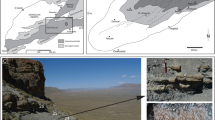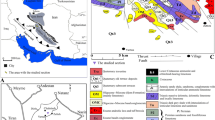Abstract
The Lower Cretaceous Chachao Formation in the Malargüe anticline area consists of wackestone, packstone, and minor grainstone and mudstone rich in benthic fauna which were deposited in a shallow carbonate ramp. These shell beds are composed of a lowdiversity molluscan fauna mostly dominated by oysters, other benthic pelecypods (Eryphila sp.,Ptychomya sp.,Pecten sp.,Pinna sp.,Trigonia sp.,Cucullaea sp.), serpulids (Sarcinella sp.,Parsimonia sp.), and occasional ammonites (Olcosthepanus curacoensis).
Most skeletal accumulations range from 15 to 70 cm in thickness. Shell beds exhibit a sharp, flat and commonly undulating base. In some cases the tops were bioturbated principally byThalassinoides isp. Some shell beds show a densely packed biofabric (bioclastic-supported) but most of them have dispersed or loosely packed biofabric (mud-supported). Bioclasts include articulated or disarticulated shells, fragmented valves and shell debris. The analysis of shell concentrations of the Chachao Formation allow to recognize four taphofacies according to their taphonomic attributes.
Different kind of processes, such as low-energy storm currents and waves, were interpreted, whose deposits are arranged into a coarsening-and thickening-upward and then fining- and thinning upward trends. According to their biostratinomic features shell beds of Chachao Formation have been interpreted as parautochthonous to autochthonous skeletal concentrations, mainly of sedimentologic origin.
Towards the end of the Valanginian, the drowning of the carbonate ramp took place, related to a relative sea level rise and environmental stress. This drowning event was recorded by the alternating thin- to medium bedded dark gray carbonate and black shales (Agrio Formation) of Late Valanginian-Late Hauterivian age.
Similar content being viewed by others
References
ABERHAN, M. and FÜRSICH, F.T., 1991, Paleoecology and paleoenvironments of the Pleistocene deposits of Bahia La Choya (Gulf of California, Sonora, Mexico),in Fürsich, F.T. and Flessa, K.W., eds., Ecology, taphonomy and paleoecology of Recent and Pleistocene Molluscan Faunas of Bahia la Choya, northern Gulf of California:Zitteliana, v. 18, p. 135–164.
GGUIRRE URRETA, M.B. and RAWSON, P.F., 1997, The ammonite sequence in the Agrio Formation (Lower Cretaceous), Neuquen Basin: Argentina:Geological Magazine, v. 134, p. 449–458.
ALLEN, J.R.L., 1990, Transport-hydrodynamic,in Briggs, D.E.G. and Crowther, P.R., eds., Palaeobiology. Blackwell Scientific Publications, London, p. 277–230.
BERNER, R.H., 1981, A new geochemical classification of sedimentary environments:Journal of Sedimentary Petrology, v. 51, p. 359–365.
BETT, C.E. and BAIRD, G.C., 1986, Comparative taphonomy: a key to paleoenvironmental interpretation based on fossil preservation:Palaios, v. 1, p. 207–227.
BRETT, C.E. and SPEYER, G.C., 1990, Taphofacies,in Briggs, D.E.G. and Crowther, P.R., eds., Palaeobiology. Blackwell Scientific Publications, London, p. 258–263.
CAROZZI, A.V., BERKOWSKI, F., RODRIGUEZ, M., SANCHEZ, M., and VONESH, T., 1981, Estudio de microfacies de la Formación Chachao (Valanginiano), Provincia de Mendoza:VIII Actas del Congress Geológico Argentino, v. 2, p. 545–565.
CONCHEYRO, A. and SAGASTI, G., 1999, Lower Cretaceous Calcareous nannofossils of Agrio Formation, Mendoza Province, Argentina: Boletim do 5° Simpósio sobre o Cretráceo do Brasil, p. 359–365.
DAMBORENEA, S., MANCEÑIDO, M. and RICCARDI, A., 1979, Estudio paleontológico de la Formación Chachao. YPF, S.A. Unpublished.
DRISCOLL, E.G. and WELTIN, T.P., 1973, Sedimentary parameters as factors in abrasive shell reduction:Palaeogeography, Palaeoclimatology, Palaeoecology, v. 13, p. 275–288.
ELLIOT, T., 1985, Siliciclastic shorelines,in: Reading, H.G., ed., Sedimentary environment and facies. 2nd Edition. Blackwell Scientific Publications. Oxford, p. 155–188.
EMERY, D. and MYERS, K.J., 1996, Sequence Stratigraphy. blackwell Scientific Publications. Oxford, p. 297.
ERLICH, R.N., BARRETT, S.F. and GUO BAI JU, 1990, Seismic and geologic characteristics of drowning events on carbonate platforms:American Association of Petroleum Geologists Bulletin, v. 74, p. 1523–1537.
ESPONA, M.J. and PALMA, R.M., 1996, Análisis e interpretación de las concentraciones fósiles de la Formación Chachao (Valanginiano)-Malargüe-Mendoza. XIII Congreso Geológico Argentino — III Congreso Exploración de Hidrocarburos:Actas, v. 2, p. 61.
FERNÁNDEZ LÓPEZ, S., 1984, Criterios elementales de la reelaboración tafonómica en amonites de la Cordillera Ibérica:Acta Geológica Hispánica, v. 19, p. 105–116.
FÜRSICH, F.T. and OSCHMANN, W.M., 1993, Storm beds as tools in basin analysis: the Jurassic of Kachchh, western India:Journal Geological Society of London, v. 150, p. 169–185.
HANDFORD, C.R. and LOUCKS, R.G., 1993, Carbonate depositational sequences and systems tracts — response of carbonate platforms to relative sea-level changes,In Loucks, R.G. and Sarg, J.F. eds. Carbonate Sequence Stratigraphy. American Association of Petroleum Geologists, Memoir 57, p. 3–41.
HAQ, B.U., HARDENBOL, J. and VAIL, P.R., 1987, Chronology of fluctuating sea levels since of the Triassic:Science, v. 235, p. 1156–1167.
KIDWELL, S.M., 1986, Models for fossil concentrations: paleobiologic implications:Paleobiology, v. 12, p. 6–24.
KIDWELL, S.M. and BOSENCE, D.W.J., 1991, Taphonomy and the time averaging of marine shelly forms,in Allison, P.A. and Briggs, D.E.G., eds., Taphonomy: Releasing the data locked in the fossil record. Plenum Press, New York, p. 115–209.
KIDWELL, S.M. and HOLLAND, S.M., 1991, Field description of coarse bioclastic fabrics:Palaios, v. 6, p. 426–434.
KIDWELL, S.M., FÜRSICH, F. T. and AIGNER, T., 1986, Conceptual framework for the analysis and classification of shell concentrations.Palaios, v. 1, p. 228–238.
KOSLOWSKY, E. CRUZ, C. CONDAT, P. and MANCEDA, R., 1990, Modelo estructural para el zócalo de la Cuenca Neuquina, Mendoza, Argentina: XI° Congreso Geológico Argentino:Actas, v. 2, p. 27–30.
KRAJEWSKI, K.P., 1984, Early diagenetic phosphate cements in the Albanian condensed glauconitic limestones of the Trata Mountains, Western Carpathians:Sedimentology, v. 31, p. 443–470.
LEANZA, H., MARCHESE, H.G. and RIGGI, J.C., 1977, Estudio sobre los cambios faciales de los estratos limítrofes jurásicoscretácisos entre Loncopué y Picún Leufú, provincia de Neuquén, República Argentina:Asociación Geológica Argentina Revista, v. 32, p. 190–208.
LEGARRETA, L. and GULISANO, C., 1989, Análisis estratigráfico secuencial de la cuenca Neuquina (Triásico superior-Terciario inferior),in Chebli G. and Spalletti, L., eds., Cuencas Sedimentarias Argentinas. Facultad de Ciencias Naturales, Universidad Nacional de Tucumán. Correlación Geológica Serie 6, p. 221–243.
LEGARRETA, L. and KOZLOWSKI, E., 1981, Estratigrafia, sedimentología y esquema prospectivo para la Formación Chachao, provincia de Mendoza:Actas VIII Congreso Geológico Argentino, v. 2, p. 521–543.
LEGARRETA, L., KOZLOWSKI, E. and BOLL, A., 1981, Esquema estratigráfico y distribución de facies del Grupo Mendoza en el ámbito surmendocino de la Cuenca Neuquina:Actas VIII Congreso Geológico Argentino, v. 3, p. 389–409.
LEGARRETA, L., GULISANO, C.A., and ULIANA M.A., 1993, Las secuencias sedimentarias jurásico-cretácicas,in: Ramos, V.A., ed, Geología y recursos naturales de Mendoza. XII° Congreso Geológico Argentino y II° Congreso de Exploración de Hidrocarburos:Relatorio, v. 1, p. 87–114.
LEGARRETA, L. and ULIANA, M.A., 1991, Jurassic-Cretaceous marine oscillations and geometry of back-arc basin fill, Central Argentine Andes,in Macdonald, D.I.M., Sedimentation, Tectonics and Eustacy. Sea-level Changes at Active Margins. International Association of Sedimentology, Special Publication, v. 12, p. 429–450.
MANCEDA, R. and FIGUEROA, D., 1993, La inversión del rift mesozoico en la Faja Fallada y Plegada de Malargüe, provincia de Mendoza. Actas XII Congreso Geológico Argentino y II Congreso de Exploración de Hidrocarburos, v. 3, p. 219–232.
MANCEDA, R. and FIGUEROA, D., 1995, Inversion of the Mesozoic Neuquén Rift in the Malargue fold and thrust belt Mendoza, Argentina,in: Tankard, A., Suárez, R., Welsink, J.H., eds., Petroleum basins of southern South America. American Association of Petroleum Geologists. Memoir 62, p. 369–382.
McKITTRICH, M.A., 1987, Experiments on the settling of gastropods and bivalves shells: Biostratinomic implications,in Flessa, K.W., ed., Paleoecology and taphonomy of Recent to Pleistocene intertidal deposits Gulf of California. The Paleontological Society, Special Publications, no. 2, 150–163.
MOMBRÚ, C., ULIANA, M.A., and BERCOWSKI, F., 1978, Estratigrafía y sedimentología de las acumulaciones biocarbonáticas del Cretácico inferior surmendocino:Actas VIII Congreso Geológico Argentino, v. 2, p. 695–709.
PALMA, R.M., 1996, Analysis of carbonate microfacies in the Chachao Formation (Cretaceous), Barda Blanca-Malargüe, Mendoza province — Argentina: a cluster analytic approach:Carbonates and Evaporites, v. 11, p. 182–194.
PALMA, R.M. and ANGELERI, M.A., 1992, Early Cretaceous serpulid limestones: Chachao Formation, Neuquén Basin, Argentina:Facies, v. 27, p. 175–178.
PALMA, R.M., ESPONA, M.J., and LANES, S.G., 1998, Stacking patterns of shell beds of Chachao Formation (Late Valanginian) in Mendoza area, Neuquen basin, Argentina. 15th International Sedimentological Congress, Spain, v. 1, p. 596–597.
PALMA, R.M. and LANÉS, S., 1996, Análisis de agrupamiento (cluster analysis) aplicado al estudio de la fauna de la Formación Chachao (Valanginiano), Barda Blanca, Malargüe, Mendoza: Acta VI Reunión Argentina de Sedimentologia, p. 161–166.
PALMA, R.M. and LANÉS, S., 1998, Análisis tafonómico-comparativo de las concentraciones esqueletales de la Formación Chachao, Mendoza-Argentina. Actas VIII Reunión Argentina de Sedimentologia, p. 160–162.
RAISWELL, R. and BERNER, R. H., 1985, Pyrite formations in euxinic and semi-euxiic sediments.American Journal of Science, v. 285, p. 710–724.
RAWSON, P.F., 1999, Long-distance correlations in the Valanginian-Hauterivian: Argentina — Western Mediterranean — NW Europe. Scripta Geologica, Special Issue, v. 3, p. 151–158.
SATTERLEY, A.K., 1994, Sedimentology of the Upper Triassic reef complex at the Hochköning Massif (Northern Calcareous Alps, Austria:Facies, v. 30, p. 119–150.
SCHLAGER, W., 1998. Exposure, drowning and sequence boundaries on carbonate platform.In G.F. and Davies, P.J., eds., Reefs and carbonate platforms in the Pacific and Indian Oceans. Camoin, International Association of Sedimentologists, Special Publication, no. 25, p. 3–21.
ULIANA, M.A., MOMBRÚ, C., and BERCOWSKI, F., 1979, Los abultamientos calcáreos del Cretácico inferior en el sur mendocino: Actas del VII Congreso Geológico Argentino, v. 2, p. 895–709.
VAIL, P.R., MITCHUM, R.M., Jr., TODD, R.G., WIDMIER, J.M., THOMPSON, S., III. SANGREE, J.B., BUBB, J.N., and HATLELID, W.G., 1977, Seismic stratigraphy and global changes of sea level.In Payton, C.R., ed., Seismic stratigraphy — applicans to hydrocarbon exploration. American Association of Petroleum Geologists, Memoir, v. 26, p. 49–212.
ZAPATA, T., BRISSÓN, I., and DZELALIJA, F., 1999, The structure of the Andean Fold and Thrust Belt in relation to basement control in the Neuquén Basin:Boletin de Informaciones Petroleras, v. 60, p. 112–121.
Author information
Authors and Affiliations
Corresponding author
Rights and permissions
About this article
Cite this article
Palma, R.M., Lanés, S.G. Shell bed stacking patterns in the Chachao Formation (early Valanginian) in Malargüe area, Mendoza province, Neuquen Basin-Argentina. Carbonates Evaporites 16, 168–180 (2001). https://doi.org/10.1007/BF03175834
Received:
Accepted:
Published:
Issue Date:
DOI: https://doi.org/10.1007/BF03175834




